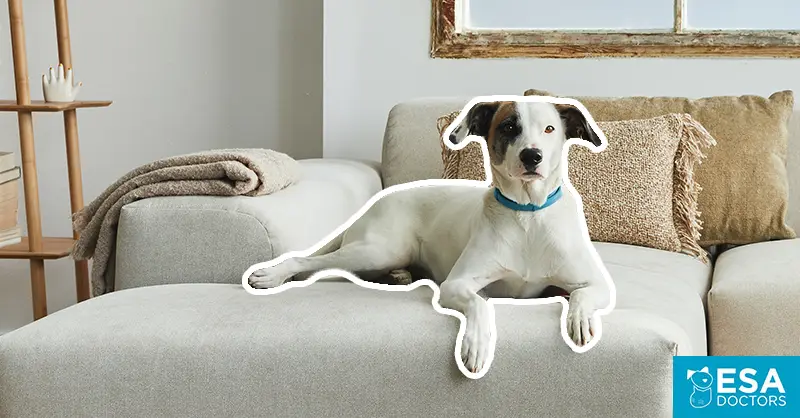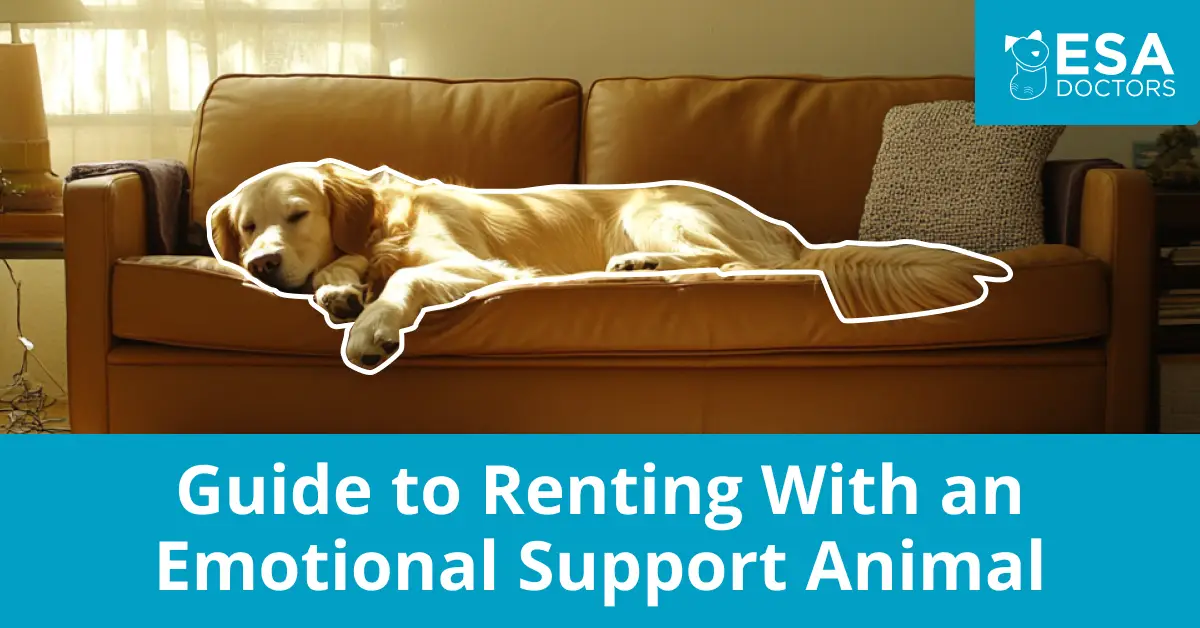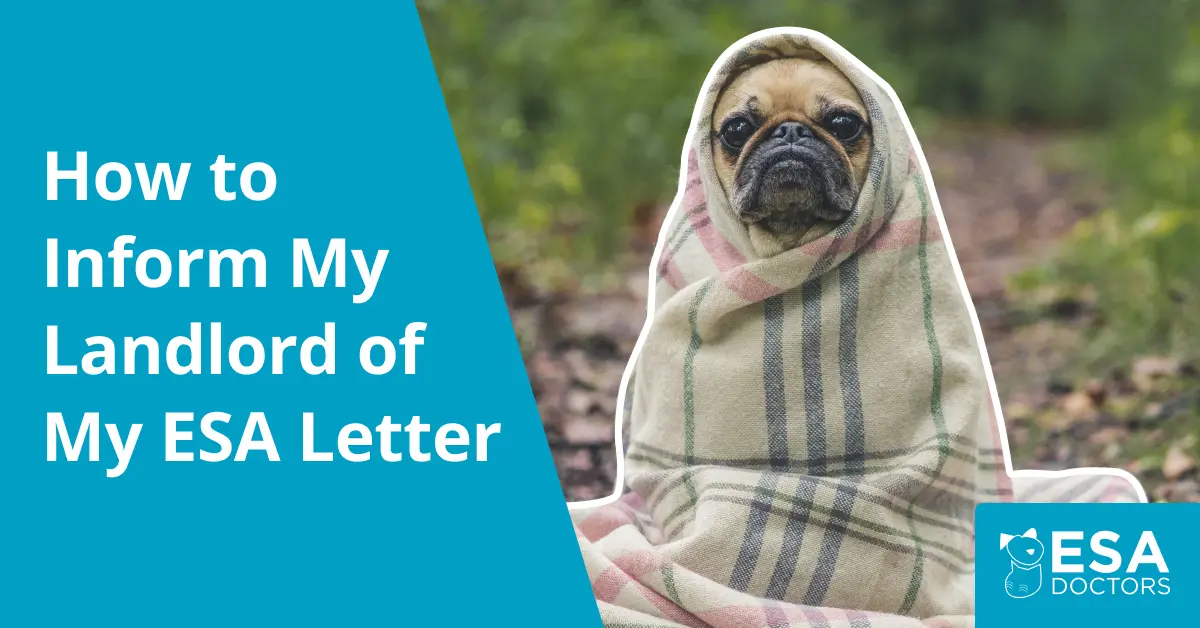Finding a pet-friendly apartment is easy, whether you are moving to a new city or want a new home where you currently live. You just need an action plan and checklist to save time and money by not touring or calling buildings that won’t meet your needs.
This guide shares how you can find pet-friendly apartments for rent in every city, suburb, and rural area in the USA, as well as some talking points to help make your search easier.
If you have an ESA letter for your pet, you have a lot more options, since no-pet rules will no longer apply, and you won’t have to pay pet fees or deposits. Click here if you’re curious about getting an ESA letter.
The Steps to Finding a Pet-Friendly Apartment
Finding a pet-friendly apartment is easy when you follow these four steps:
- Create a checklist of what is important to you
- Research the neighborhoods that best match your lifestyle
- Begin searching two months before your move
- If you have time, do a short-term rental until more spaces free up, like in the summer
- Set up tours and track your thoughts
The process is simple when you’re prepared, so we’ve put together more details for each step to help make your search as hassle-free as possible.
Create a Checklist
Having the things that matter to you in a home listed in a spreadsheet makes it easier to track which property gives you the lifestyle you want and remain within budget. In your spreadsheet, the columns can be the properties you’re visiting, and the rows are the amenities, features, and options that matter to you.
Your spreadsheet should include everything from financial information like rent, utility costs, pet deposits, and monthly fees, as well as how much it costs to break your lease if you have to move. Then there are features in the apartment that make your life more comfortable, like a washer and dryer, assigned parking spaces, a full kitchen vs. a kitchenette, even a bathtub vs. a shower if you enjoy a soak.
And don’t forget the location. If you love running or cycling, are there trails nearby? What about dog parks and places for your pets to explore safely or use the restroom? How easy will it be to commute to work, and if you enjoy nightlife, how easy will it be to get to the venues and home, on a scale of 1 to 10?
Here’s a sample spreadsheet to help you get started:
| Property | Street #28 | 45th Avenue | Alley 5 | Park 18 |
|---|---|---|---|---|
| Base rent $ | $1,000 | $700 | $1,400 | $1,100 |
| Monthly utilities $ | $50 | $100 | Included | Included |
| Lease length | 12 months | 12 months | 6 months | 12 months |
| $ to break the lease | Buy the remainder | Buy the remainder | $2,800 or two months’ rent | Buy the remainder |
| Pet fees (annual, monthly, deposits) | None | $100 annual + $200 deposit | $50 per month and $250 deposit | $25 per month |
| Dog park nearby | Yes, ½ mile | No | Yes, on site | Yes ½ mile |
| Parking space (price and assigned) | Free, not assigned | $150 per month, assigned | Free, first-come, first-served | $200 per month, assigned |
| In-unit washer and dryer | N | N | Y | Y |
| Fitness center | Y | N | N | Y |
| Public transport within walking distance | N | Y | Y | N |
| Time to commute to work | 1 hr | 10 minutes | 30 minutes | 30 minutes |
| Balcony or patio | Y | N | N | Y |
Research Neighborhoods
Researching the neighborhoods you’re interested in can make all the difference in your lifestyle now and in five years, if you plan on staying long-term. Most city and town governments publish their infrastructure plans, which include building new schools, creating entertainment venues, and parks or recreational facilities.
If there is no dog park nearby now, there could be in a year, and there could also be an investment in restaurants and shopping districts. You may need to go a bit further for a dog park currently, but in one year, all of the things you want will be at your doorstep, and you may lock in a lower price on rent before they skyrocket.
In addition to your own life, you want to make sure there are resources for your pet within a reasonable distance, including:
- Pet supply stores
- Veterinary practices
- Veterinary hospitals
- Dog runs and recreational parks for people and pets
- Check the leash laws and see if there is an area where dogs can run free
- Pet-friendly cafes, restaurants with happy hours that welcome pets, and other places you can enjoy with your pet if you’d like
Choosing the right neighborhood saves you time during your apartment hunt. While you might find a unit with the perfect price and aesthetics, if the location doesn’t support your daily routines and pet care needs, you’ll face ongoing inconveniences and additional costs. Taking time to identify the right location is one of the most important steps in finding a pet-friendly apartment.
Begin Your Search
The first step to searching for a pet-friendly apartment is to use places that have already verified a building as acceptable of pets, saving you countless hours scrolling through search engine results, apartment images, and forum postings.
Here are some places to start:
- Apartment and rental marketplaces with pet filters, like apartments.com, Rent Cafe, rent.com, and even Zillow.
- Look for apartment hunters in the area you’re moving to and fill out their questionnaire, which includes what is important to you and that you have pets. They charge a small fee but help narrow down the options for where you’ll be happy and likely qualify to move in.
- Contact local real estate agents who offer rental units. If they do not have any available, real estate agents are notorious networkers and will likely be able to connect you to one that does.
- Contact a large concierge company that staffs apartment and condo buildings with team members. They’ll have a list of pet-friendly buildings. Even if the building is condos and not apartments, some units may be for rent, saving you time searching through endless listings.
Once you have 10 or so buildings in the neighborhoods you want, get your spreadsheet out from the beginning of this post. Now use the filters on the website to see if you can narrow available units for the time frame you need to move.
Once you do, look through the pictures and begin filling out the checklist. This helps you narrow down which apartments are worth touring and which do not have what you need to live a happy life with your pet.
Money-saving tip: If you can move during the slow season, you may be able to negotiate the rent price since empty units mean no money for the landlord. There is a chance you can lock in the amount they’re able to increase rent each year, keeping your unit affordable.
If your options still include more than 5 or 6 buildings, you’ll need multiple days to tour, as you could get stuck in traffic. To further narrow it down to three or four apartment buildings:
- Check for community boards and look for pet complaints or pet lovers commenting.
- If the apartment building shows up in Google, read the reviews and look for tags like pet friendly, dogs, or cats. Keep in mind that people may only leave a review when they’re angry, negative reviews may be older, and the building has changed since then.
- Call the building and ask about pet policies. Bedside manners can mean a lot, and if they start off negatively, what happens if something goes wrong while you’re renting? This is a great way to determine how your life will be when you move in and need something.
- Compare their pet policies and see which ones seem like overkill vs. being reasonable.

Set Up Tours and Track Your Thoughts
Now that your pet-friendly apartment search has been narrowed down to a reasonable number, it is time to set up the tours. This is the easiest part.
As you go through the building, consider your life while living there and check the boxes from your checklist in the first section. Are the elevators fast or slow, and do you see other pet parents walking around? Do you feel at home and welcomed, or does it come off as gloomy and uninviting? If you have a bad day at work, you don’t want to get home and walk through an aesthetic that doesn’t lift your spirits.
Talk to everyone in the rental office if there’s more than one person, and pay attention to how they talk and interact with each other. If the phone rings and they’re talking to a tenant, you’ll get a first-hand experience of how they handle situations. Each moment matters because you commit to a time frame that will likely last a year.
Using the information above, you’ll be able to narrow your search to save time and money when finding a pet-friendly apartment. If you have a tip that helped you on your apartment search before, leave a comment below to help others on their quest for a pet-friendly apartment building.
If you have an emotional support animal, you can skip the hassle of finding a pet-friendly apartment entirely since you’re exempt from pet restrictions and pet rent. You might qualify if you have a history of mental health issues. Click below to work with a licensed healthcare professional to see if you meet the criteria.





Can animals that are not friendly be certified as companion, therapy or Comfort animals?
Yes, but you must be in control of the animal at all times. You are responsible for your ESA’s actions.
It’s helpful that you pointed out the importance of understanding the pet policy of the apartment that you’re interested in to make sure that your pet is allowed in your apartment room. My son is looking for an apartment that will allow him to bring his dog with him. He wants to make sure that he won’t have problems in bringing his dog to his new apartment, so I will be sure to share your article with him.
[…] Finding an apartment that allows for pets can be difficult, but ESAs and their owners are entitled to reasonable accommodation and housing. Under Title II of ADA, people with ESAs are provided reasonable accommodation for animal as assistive aids. For example, just as property owners are required to make buildings wheelchair accessible, accommodations are also made to make buildings animal accessible. Additionally, ESA owners cannot be denied housing. Further to this point, property owners are not allowed to exclude breeds, charge fees and deposits such as pet deposits. […]